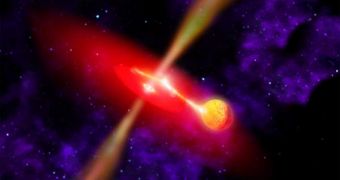Usually, when analyzing the skies with advanced telescopes, the only types of black holes whose existence can be inferred from their effects on normal matter are either the small or the supermassive kind. For many years, there seemed to be no intermediary stages in their development, a fact that had astronomers puzzled as to the causes. However, there were those who suggested that middleweight black holes must also exist, and new studies appear to show that they were correct, Space reports.
“Intermediate-mass black holes contain between 100 and 10,000 times the sun's mass. We observe the heavyweight black holes in the centers of galaxies and the lightweight ones orbiting stars in our own galaxy. But finding the 'tweeners' remains a challenge,” Tod Strohmayer explains. The expert is an astrophysicist at the NASA-operated Goddard Space Flight Center, in Greenbelt, Maryland. The celestial body that spawned the new excitement was discovered approximately 15.8 million light-years away from our solar system, in the constellation Centaurus.
In the NGC 5408 galaxy, the European Space Agency's (ESA) orbiting XMM-Newton observatory managed to identify an X-ray source that may very well represent the intermediary step astronomers were looking for. The body was observed for the first time in 2006, and then again in 2008. The latter study gathered even more proof that the formation was a medium-sized black hole. The object NGC 5408 X-1, emits far more X-rays than a star, but significantly less than a supermassive black hole, which can grow to a combined mass rivaling that of a million suns.
“Astronomers have been studying NGC 5408 X-1 for a long time because it is one of the best candidates for an intermediate-mass black hole. These new results probe what is happening close to the black hole and add strong evidence that it is unusually massive,” University of Iowa scientist Philip Kaaret adds. He was not involved in the new study, but spent a lot of time studying the X-ray source at radio wavelengths. The new investigation has been accepted for publication, and will appear in an upcoming issue of The Astrophysical Journal.

 14 DAY TRIAL //
14 DAY TRIAL //